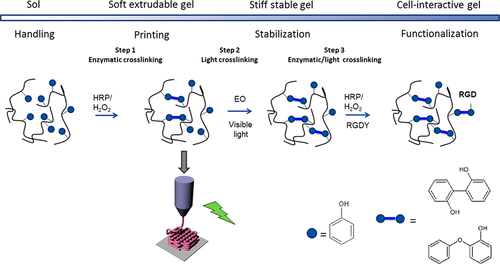当前位置:
X-MOL 学术
›
ACS Biomater. Sci. Eng.
›
论文详情
Our official English website, www.x-mol.net, welcomes your
feedback! (Note: you will need to create a separate account there.)
Three-Dimensional Printing of a Tyramine Hyaluronan Derivative with Double Gelation Mechanism for Independent Tuning of Shear Thinning and Postprinting Curing
ACS Biomaterials Science & Engineering ( IF 5.4 ) Pub Date : 2018-07-09 00:00:00 , DOI: 10.1021/acsbiomaterials.8b00416 Dalila Petta 1, 2 , Dirk W. Grijpma 2 , Mauro Alini 1 , David Eglin 1 , Matteo D’Este 1
ACS Biomaterials Science & Engineering ( IF 5.4 ) Pub Date : 2018-07-09 00:00:00 , DOI: 10.1021/acsbiomaterials.8b00416 Dalila Petta 1, 2 , Dirk W. Grijpma 2 , Mauro Alini 1 , David Eglin 1 , Matteo D’Este 1
Affiliation

|
Biofabrication via three-dimensional printing (3DP) is expanding our capabilities of producing tissue engineering constructs for regenerative medicine, personalized medicine, and engineered tissue models of disease and diagnostics. Hydrogel-based materials for extrusion-based printing have been introduced; nevertheless, it is still challenging to combine into a single biomaterial all the requirements of an ink. These inks need to flow for extrusion under low shear, yet have immediate shape retention after deposition, provide a biochemical environment similar to that of physiological extracellular matrix, and a curing mechanism avoiding cell damage. This work introduces a simple and versatile tyramine-modified hyaluronan material (HA-Tyr) for extrusion-based printing, featured by (i) single component yet two distinct cross-linking mechanisms, allowing (ii) shear-thinning tuning independently of the postprinting curing; (iii) no rheological additives or sacrificial components; (iv) curing with visible light for shape stability; (v) possibility to postfunctionalize; and (vi) preservation of hyaluronan structure owing to low modification degree. The ink is based on a hydroxyphenol hyaluronan derivative, where the shear thinning properties are determined by the enzymatic cross-linking, while the final shape fixation is achieved with visible light in the presence of Eosin Y as photosensitizer. The two cross-linking mechanisms are totally independent. A universal rheologically measurable parameter giving a quantitative measure of the “printability” was introduced and employed for identifying best printability range within the parameter space in a quantitative manner. 3DP constructs were postfunctionalized, and cell-laden constructs were produced. Due to its simplicity and versatility, HA-Tyr can be used for producing a wide variety of 3D printing constructs for tissue engineering applications.
中文翻译:

具有双胶凝机理的酪胺透明质酸衍生物的三维印刷,可独立调节剪切稀化和印后固化
通过三维打印(3DP)进行生物制造正在扩展我们生产再生医学,个性化医学以及疾病和诊断学的工程组织模型的组织工程构造的能力。已经介绍了用于挤出印刷的水凝胶基材料。然而,将墨水的所有要求组合到一个生物材料中仍然是一个挑战。这些油墨需要在低剪切力下流动以挤出,但在沉积后具有立即的形状保持性,提供类似于生理细胞外基质的生化环境,以及避免细胞损伤的固化机理。这项工作介绍了一种简单且用途广泛的酪胺修饰的透明质酸材料(HA-Tyr),可用于基于挤出的印刷,其特点是(i)单组分和两种截然不同的交联机理,(ii)独立于印后固化进行剪切稀化调整;(iii)没有流变添加剂或牺牲成分;(iv)用可见光固化以保持形状稳定;(v)后功能化的可能性;(vi)由于修饰度低而保持透明质酸结构。该油墨基于羟基苯酚透明质酸衍生物,其中剪切稀化特性由酶交联决定,而在曙红Y作为光敏剂的情况下,可见光可实现最终的形状固定。两种交联机制是完全独立的。介绍了一种通用的流变学可测量参数,该参数给出了“可印刷性”的定量度量,并用于定量确定参数空间内的最佳可印刷性范围。将3DP构建体进行后功能化,并生产出富含细胞的构建体。由于其简单性和多功能性,HA-Tyr可用于生产用于组织工程应用的各种3D打印构造。
更新日期:2018-07-09
中文翻译:

具有双胶凝机理的酪胺透明质酸衍生物的三维印刷,可独立调节剪切稀化和印后固化
通过三维打印(3DP)进行生物制造正在扩展我们生产再生医学,个性化医学以及疾病和诊断学的工程组织模型的组织工程构造的能力。已经介绍了用于挤出印刷的水凝胶基材料。然而,将墨水的所有要求组合到一个生物材料中仍然是一个挑战。这些油墨需要在低剪切力下流动以挤出,但在沉积后具有立即的形状保持性,提供类似于生理细胞外基质的生化环境,以及避免细胞损伤的固化机理。这项工作介绍了一种简单且用途广泛的酪胺修饰的透明质酸材料(HA-Tyr),可用于基于挤出的印刷,其特点是(i)单组分和两种截然不同的交联机理,(ii)独立于印后固化进行剪切稀化调整;(iii)没有流变添加剂或牺牲成分;(iv)用可见光固化以保持形状稳定;(v)后功能化的可能性;(vi)由于修饰度低而保持透明质酸结构。该油墨基于羟基苯酚透明质酸衍生物,其中剪切稀化特性由酶交联决定,而在曙红Y作为光敏剂的情况下,可见光可实现最终的形状固定。两种交联机制是完全独立的。介绍了一种通用的流变学可测量参数,该参数给出了“可印刷性”的定量度量,并用于定量确定参数空间内的最佳可印刷性范围。将3DP构建体进行后功能化,并生产出富含细胞的构建体。由于其简单性和多功能性,HA-Tyr可用于生产用于组织工程应用的各种3D打印构造。











































 京公网安备 11010802027423号
京公网安备 11010802027423号